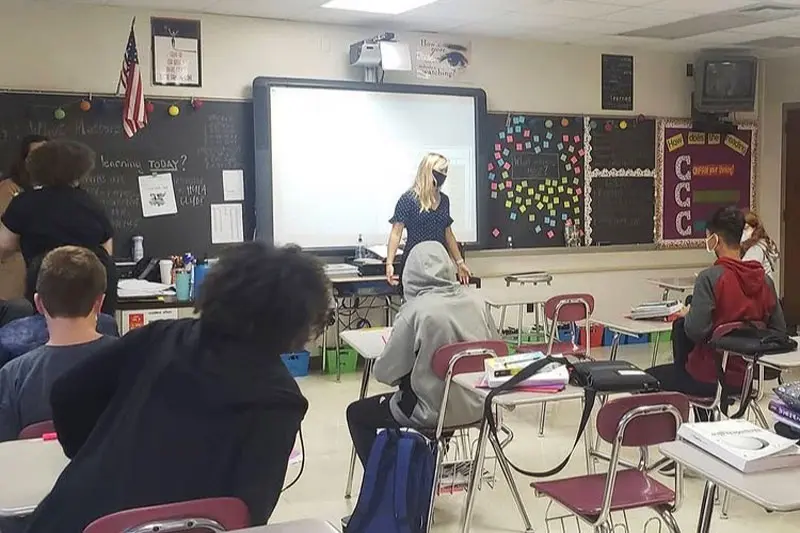-
-
- Financial Aid
- Financial Aid
- Scholarships
- Loans
- Grants
- Federal Work Study
- Additional Resources
-

Every student at Taylor University receives a wealth of opportunities and support that prepares them for their future careers, both through their field of study and the the Foundational Core. For Education majors, classroom experience starts freshmen year, culminating in a full semester student teaching in their senior year. This is where Cali Saunders (’21) found out how Taylor prepared her to teach well and to connect with students at a personal level.
Saunders, a Secondary English Education major, spent her final fall semester teaching at two schools: North Central High School in Indianapolis and Speedway Jr. High School in Speedway, Indiana.
Due to the pandemic, Saunders spent her entire first placement teaching virtually at North Central High School. Teaching online presents many challenges both physically and emotionally, but Saunders was ahead of the game. In recent years, even pre-pandemic, Taylor has adapted its education curriculum as more schools have begun migrating to more online and blended learning.
“We have an educational technology course that is specifically designed to help our students be aware of those issues and resources that are necessary to implementing technology in the classroom,” said Associate Professor Ben Hotmire, chair of the Education Department.
While over Zoom, Saunders got a real look into her students' home lives in a way that wasn’t possible outside of a virtual classroom. While many of these were amazing stories, some showed the true struggles people face at home during quarantine.
“Every day took place on Zoom, so there were some super fun stories of students bringing their little siblings to class or showing us their pets,” Saunders said. “There were also some super hard stories of students dealing with loud family members, faulty technology, poor WiFi, and worse.”
While these challenges persisted, Saunders constantly adapted to meet the needs of students. Modeling after her professors, she became more flexible and more compassionate towards her students especially in regards to the pandemic.
“Being flexible was absolutely crucial,” Saunders said. “Being flexible meant understanding that some students would not be able to connect to my class, and being willing to trust them to complete whatever I would send them.”
According to Hotmire, this is something that the education department adamantly stands by and teaches.
“The Teacher Education program emphasizes the importance of healthy and strong relationships between teachers and students in the process of teaching and learning. This is a concept that we discuss in all of our courses, and something that we model in our program,” Hotmire said. “So as teachers, we must know our students well and understand what outside factors, like personal issues, might be negatively impacting the learning process.”
Saunders constantly adapted to help her students face change and hardship. She understood what was negatively impacting them and did what she could to help her students succeed in the classroom.
At her second placement, Speedway Jr. High School classes were all in-person, which had their own benefits and drawbacks as well. Many of the lessons Saunders had wanted to try, such as group projects and discussions, weren’t possible. However, she still made the most of her time teaching the students.
While Speedway Jr. High School took all the precautions they could, many students still tested positive for the virus or had to be quarantined due to close contacts testing positive.
“The administration would make calls down to my classroom to tell me who was being quarantined,” Saunders said. “I felt partly like the Grim Reaper and partly like the host of “The Bachelor” when I would have to walk up to a student and say, ‘pack your things. You're going home.’ Many times, they would sob. It was awful.”
What made it worse was when students were quarantined, they sometimes “dropped off the grid," falling behind in work and rarely showing up for class. One of Saunders’ students returned from quarantine with signs of abuse. Police and counselors immediately got involved, and Saunders did her best to care for the student in class.
According to Hotmire, Taylor provides support for student teachers through the professors’ advice, host teachers, and dedicated supervisors. Through this network, student teachers have support that they can lean on in stressful situations.
Saunders faced many challenges during her time as a student teacher, and there were many times she felt it was all worth it.
“Another powerful moment was toward the end of student teaching,” Saunders said. “I got engaged, and my eighth graders all started giving me marriage advice, which was so fun and such a testament to their brilliant personalities.”
While teaching, Saunders grounded herself in the love of Jesus and in the examples provided to her by the teachers and faculty members in the Education Department. Even with her challenging student-teacher experiences, she is still extremely excited to be a teacher and to build these strong connections with her future students.
Taylor’s Education department helps prepare students for a career in teaching. If you want to start on your own path to teaching, click here to explore Taylor’s Education programs.